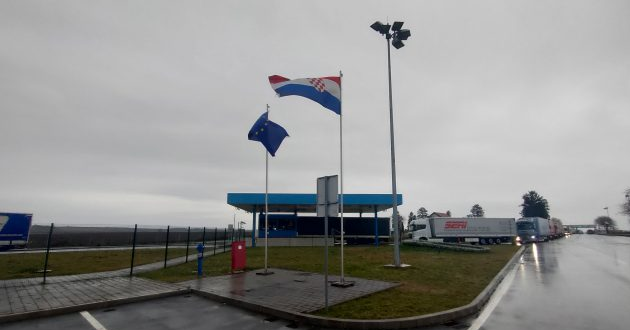Accession to the EU in 2013 and to the Schengen zone on January 1 has meant a serious upgrade when it comes to policing Croatia’s border with Serbia. Illegal crossing are unlikely to go undetected, but that does not stop some from trying.
The external frontier of Europe’s passport-free Schengen zone edged eastwards on January 1. Not that you’d have noticed much difference on Croatia’s border with Serbia, where border officers say preparations had been underway for years.
At the Tovarnik border crossing, in a room approximately four metres by five, a single police officer sits in front of four computer monitors and a large wall-mounted screen, monitoring 19.5 kilometres of the so-called ‘green border’ between official border points.
Officers here say their thermal imaging cameras are so sensitive they can tell the difference between a rabbit and a pheasant crossing the fields between Serbia and the European Union’s youngest member.
A human stands little chance of passing undetected.
Pero Ruzolcic, head of the border police in Tovarnik, said the upgrade began well before Croatia joined the EU in mid-2013.
And far from a sign of teething troubles, long queues at the border in the days after Croatia joined the Schengen zone were much as expected during the festive season.
“From the pre-accession funds, we already acquired equipment for border control and surveillance, vehicles, cameras – stationary and mobile – motiondetectors, radars,” Ruzolcic told BIRN.
“And when we take into account the configuration of the ground and the fact that this area is a plain, we can be satisfied.We have a complete overview of the border.”
Border upgrades
For much of the 20th century, when Croatia and Serbia were both part of socialist Yugoslavia, there was no border here. Now, it is armed with cameras up and down its 317.6 km.
In Vukovar-Srijem County, which takes in roughly half the length of the border, there are 13 thermal imaging cameras, each with a range of up to 10 km.
Tovarnik was grim the winter morning when this reporter visited. Traffic was slow.
“Nothing significant has changed since January 1; preparations for entering the Schengen zone began with Croatia’s entry into the European Union, so January 1 did not really bring anything new to our work,” Ruzolcic told BIRN.
His deputy, Ivan Peulic, said: “We harmonised the national legislation with the Schengen acquis even before entering the European Union, so we didn’t have to make any major changes when the date came. We adopt and adapt to the European Commission directives.”
Well before Croatia’s accession to the Schengen zone, the police stations at Tovarnik, Ilok, and Bajakovo – on the highway between Serbia and Croatia – were renovated, as were the crossing points themselves.
Then, several years ago, the Croatian police were enrolled into Schengen Information System 2, or SIS2, which oversees the entire external border of the EU.
Officers from the EU border agency, Frontex, were seconded to the Croatian border, sharing their expertise in detecting forged documents and stolen vehicles and in dog handling.
Rights criticism
Croatia’s preparedness was tested in 2015 at the start of the so-called ‘migrant crisis’, when hundreds of thousands of refugees and migrants streamed across the Balkans trying to reach Western Europe.
Since then, human rights organisations and journalists have documented widespread abuse of international asylum rules by Croatian police, including the use of violence and illegal ‘pushbacks’.
Border officers say that anyone trying to cross the border outside the regular border crossings will be met by a police patrol. In general, they are given seven days to leave and face being banned from entering Croatia for a substantial period of time.
It’s this seven-day period that some refugees and migrants use to press on deeper into the EU; otherwise, they face being returned to Serbia, or Bosnia and Herzegovina, depending from which country they entered.
Officials say the migrants and refugees expect to be picked up. Indeed, if they are not, it may be a sign that the police are monitoring their onward progress to see whom they meet, potentially the ‘guides’, or smugglers’, who make big money facilitating the flow.
Once the work of Croatian or Serbian locals, Afghans, Pakistanis or Moroccans now dominate the smuggling trade. There people will frequently intercept those who set out to cross the border of their own accord, say border officers, but proof of payment is hard to come by.
 Eurasia Press & News
Eurasia Press & News




